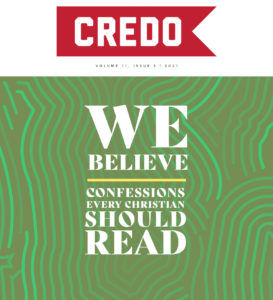
Our Only Comfort in Life and Death: An Invitation to the Heidelberg Catechism
The latest issue of C redo Magazine focuses on Confessions every Christian should read. The following is one of the issue’s featured articles by Daniel R. Hyde, pastor of Oceanside United Reformed Church in Carlsbad/Oceanside, CA, and Adjunct Instructor at Mid-America Reformed Seminary and Puritan Reformed Theological Seminary.
redo Magazine focuses on Confessions every Christian should read. The following is one of the issue’s featured articles by Daniel R. Hyde, pastor of Oceanside United Reformed Church in Carlsbad/Oceanside, CA, and Adjunct Instructor at Mid-America Reformed Seminary and Puritan Reformed Theological Seminary.
Hey fellow sinners! How do you know you are SAVED? Why do you believe what you SAY you believe? Tragically many Christians… do not have a clue as to WHY they believe it from the Holy Scriptures…. If you will study this inspiring little volume in one hand with your Bible in the other, you will know why you believe what you say you believe…. I commend this historic volume to you knowing the body of Christ will be stronger and better equipped to build the Kingdom together!
I had been a Christian all of two years. I was disillusioned by my Pentecostal experience. Then I heard the Heidelberg Catechism mentioned on the White Horse Inn, and I had to find a copy. I checked the college bookstore; no luck. I went to Calvary Chapel Costa Mesa’s bookstore; no way Jose! Then I found a Christian bookstore with a large used section. I wandered around, scanned dozens upon dozens of shelves. Eureka!
I was a 19-year old, disillusioned, Pentecostal college student searching out a 400-year old catechism. I opened it, read the above Foreward, and noticed the words came from Paul Crouch of the Trinity Broadcasting Network! This couldn’t be right. A Word of Faith preacher recommending the catechism I heard on the White Horse Inn? Amazingly, it’s true.
I still have that little paperback on my shelf to remind me “I once was lost, but now am found.” I want to invite you to take up this Heidelberg Catechism so that you’ll discover its joys and treasures for yourself.
Highlights of the Heidelberg: The Who, What, When, Where, & Why
When was the Heidelberg Catechism published? January 19, 1563. That’s only 90 years since the final fall of the Roman Empire at Constantinople to the Ottoman Turks; 46 years since Martin Luther nailed his Ninety-Five Theses; 37 years since William Tyndale published his New Testament; 34 years since the Ottomans were seen at the gates of Vienna; 4 years since the final edition of John Calvin’s Institutes, and just 1 month since the Council of Trent came to an end. It had been a turbulent century and even decade.
Where was it written and published? In Heidelberg, the capital city of the Palatinate. This was a German-speaking region within the Holy Roman Empire. Its roots were ancient, being mentioned as far back as the 6th century during the time of the Frankish King, Childebert I.The roots of catechisms come from Old Testament creeds and confessions like the Shema (Deut. 6:4) and the New Testament’s “Christ is Lord! Click To Tweet
By 1546 Protestantism was the religion of the realm. Yet Charles V, Holy Roman Emperor, crushed the Protestants in 1547 at the Battle of Mühlberg, and the Augsburg Interim re-introduced Roman practice with minor concessions of communion in both kinds and clerical marriage. The 1555 Peace of Augsburg granted secular princes the right to determine their realms’ religion between Lutheranism and Catholicism. In 1556 Otto Heinrich began to reign as an enthusiastic Lutheran. Yet by adding professors of various theological stripes to Heidelberg University, he caused factions between strict Lutherans, Melanchthonian Lutherans, and Zurich-minded Reformed men. Otto died and his successor, Frederick III, sponsored a Disputation from June 3–7, 1560 on the mode of Christ’s presence at the Lord’s Supper leading to him supporting the Reformed cause.
What is a “catechism?” It’s not a Roman Catholic thing but a small “c” catholic thing, meaning, an ancient Christian thing. The roots of catechisms come from Old Testament creeds and confessions like the Shema (Deut. 6:4) and the New Testament’s “Christ is Lord!” “Catechism” comes from the Greek verb κατηχέω, which is a compound word from κατα, “down,” and ηχέω, “sound;” thus meaning, “I sound down” (Luke 1:4; Acts 18:25; 21:2, 24; Rom. 2:18; 1 Cor. 14:19; Gal. 6:6). Catechism is teaching by using questions and expecting an answer. The early Church needed a basic way to guide new converts and members of Christ’s Church into knowledge of what they believed. They had to be “catechized.” The basic outline was the Apostles’ Creed, the Sacraments, the Lord’s Prayer, and the Ten Commandments.
Who wrote the Heidelberg Catechism? I’ve already mentioned its “father,” Elector Frederick III. He is said to have read over it several times when in draft form to compare it with the Word. When he was called to defend it before the Imperial Diet of Augsburg against the charge that it was written by Heinrich Bullinger, he said he could show in his own handwriting how he improved it in several places!
When it was published, Frederick appended a letter which claimed it was written “with the advice and cooperation of our entire theological faculty…and of all Superintendents and distinguished servants (or, ministers) of the Church.” Since the Palatinate had come into the Reformation with several factions and viewpoints within its ministers and faculty, anonymity and collective authorship stressed the unity of the Elector’s reformation between Calvinist, Zwinglian, and Philippist influences.
The theological faculty consisted of Zacharius Ursinus (1534–83), a twenty-eight year old professor of theology, Immanuel Tremmelius, professor of Old Testament, and Petrus Boquinus, professor of New Testament. The superintendents were nine pastors whose tasks included ordaining other pastors, visiting the congregations in their districts twice a year, and leading and preaching in vacant congregations.
One of the most well-known and important to the Catechism was Caspar Olevianus (1536–87), a twenty–six year old preacher at St. Peter’s Church and later Heidelberg’s main Holy Spirit Church. Amongst the distinguished servants (ministers) of the Church was Thomas Erastus (1524–83), professor of medicine at the University, Frederick’s personal physician, and a lay member of the Palatinate’s Kirchenrat or church council.
Why was this Catechism written? Frederick’s appended letter described the problem being that the youth of his principality were “disposed to be careless in respect to Christian doctrine, both in the schools and churches.” Some weren’t instructed at all while others were instructed in an unsystematic way without a clear catechism. The Catechism was the remedy. It was intended to do three things: 1) provide a “fixed form and model” of Christian doctrine for his realm; 2) instruct the youth of the Palatinate in school and church; and 3) enable the pastors and schoolteachers of the Palatinate to preach/teach.
The Theme of the Heidelberg: Living and Dying in Comfort
Let’s focus on the Heidelberg Catechism’s two opening programmatic questions and answers, Q&A 1 introduces the theme of the Catechism: Living and Dying in Comfort. Sometimes preachers come up with more alliterated, memorable outlines such as Guilt, Grace, and Gratitude; or Sin, Salvation, and Service. This “threefold knowledge” as one commentator called it, follows the big picture of Paul’s letter to the Romans. After his introductory greetings in Romans 1:1–17, Paul goes on to speak of worldwide judgment (1:18–3:20), salvation for the world of Jews and Gentiles (3:21–11:36), and how the saved are to live in sacrificial service to one another (chs. 12–16).
Q&A 1, the theme, asks and answers:
What is your only comfort in life and in death?
That I am not my own, but belong—body and soul, in life and in death—to my faithful Savior, Jesus Christ. He has fully paid for all my sins with his precious blood, and has delivered me from the tyranny of the devil. He also watches over me in such a way that not a hair can fall from my head without the will of my Father in heaven; in fact, all things must work together for my salvation. Because I belong to him, Christ, by his Holy Spirit, also assures me of eternal life and makes me wholeheartedly willing and ready from now on to live for him.
What is “Comfort?”
Don’t impute an image of feeling “comfy” or being “comfortable” when you hear comfort (trost, German; consolatio, Latin). Ursinus wrote, “Comfort is that which results from a certain process of reasoning, in which we oppose something good to something evil, that by a proper consideration of this good, we may mitigate our grief, and patiently endure the evil.”Comfort speaks of the assurance that I ultimately will be in the presence of God. Click To Tweet
When I compare and contrast the good of Jesus Christ’s grace with the evil of my sins, I experience trost, consolatio, comfort; I experience certainty. Ursinus explained that comfort is “the assurance and confident expectation” that we will have a “full and perfect enjoyment” of our salvation “in the life to come, with a beginning and foretaste of it already, in this life.” Comfort speaks of the assurance that I ultimately will be in the presence of God.
Having comfort is so urgent and vital. Sudden and tragic deaths remind the world that life under the sun is fallen, fragile, fleeting, and feels futile. We’re all going to die. Karl Barth wrote, “Human life has an eschatological edge, a boundary line.” In the words of King Solomon, whether you’re righteous or wicked, good or evil, clean or unclean, make a sacrifice to God or not: “as the good one is, so is the sinner…the same event happens to all” (Ecc. 9:2, 3).
The Lord God told Adam after sinning: “You are dust, and to dust you shall return” (Gen. 3:19). David memorably sung the Lord “knows our frame; he remembers that we are dust. As for man, his days are like grass; he flourishes like a flower of the field; for the wind passes over it, and it is gone” (Ps. 103:14–16). Job reflected on humanity: “He comes out [of the womb] like a flower and withers; he flees like a shadow and continues not” (14:2). It’s urgent to have all-encompassing comfort body and soul, in life and in death.
Personal Comfort
What is your only comfort…That I am not my own. This isn’t some frozen or static question. It’s personal; it’s passionate! Whenever you read question 1, you’re confronted with recommitting yourself to the Triune God. If you do not yet trust in Jesus, this question asks you to consider what you’re hoping in. This isn’t merely a head-knowledge kind of question and answer either. B.B. Warfield criticized this personalness saying the Heidelberg is overly subjective in contrast to the objective Westminster Catechisms. But the Heidelberg teaches that our subjective comfort is rooted in and produced by what is objectively good. Comfort is Christological. Heidelberg begins with who we are in Christ, while Westminster begins with what we ought to do.The Heidelberg Catechism teaches that our subjective comfort is rooted in and produced by what is objectively good. Comfort is Christological. Click To Tweet
The Christ of our Comfort
After we say what our only comfort is, we go on to express why Jesus is our only comfort: that I am not my own, but belong…to my faithful Savior, Jesus Christ. “For none of us lives to himself, and none of us dies to himself. For if we live, we live to the Lord, and if we die, we die to the Lord. So then, whether we live or whether we die, we are the Lord’s” (Rom. 14:7–8); “[Christ] gave himself for us” that we might be “a people for his own possession” (Tit. 2:14). I belong to Jesus Christ; this is the key to comfort. Belonging to Christ is “uniquely Christian comfort.” Why? Because it’s
. . . a comfort consisting in the assurance of the free remission of sin, and of reconciliation with God, by and on account of Christ, and a certain expectation of eternal life, impressed upon the heart by the holy Spirit through the gospel, so that we have no doubt but that we are the property of Christ, and are beloved of God for his sake, and saved forever.
We belong to Christ; what’s he done to make us his own? The answer goes on to list theological descriptions of what Jesus did; but these aren’t merely theological words, they’re our responses to the devil’s accusations.

